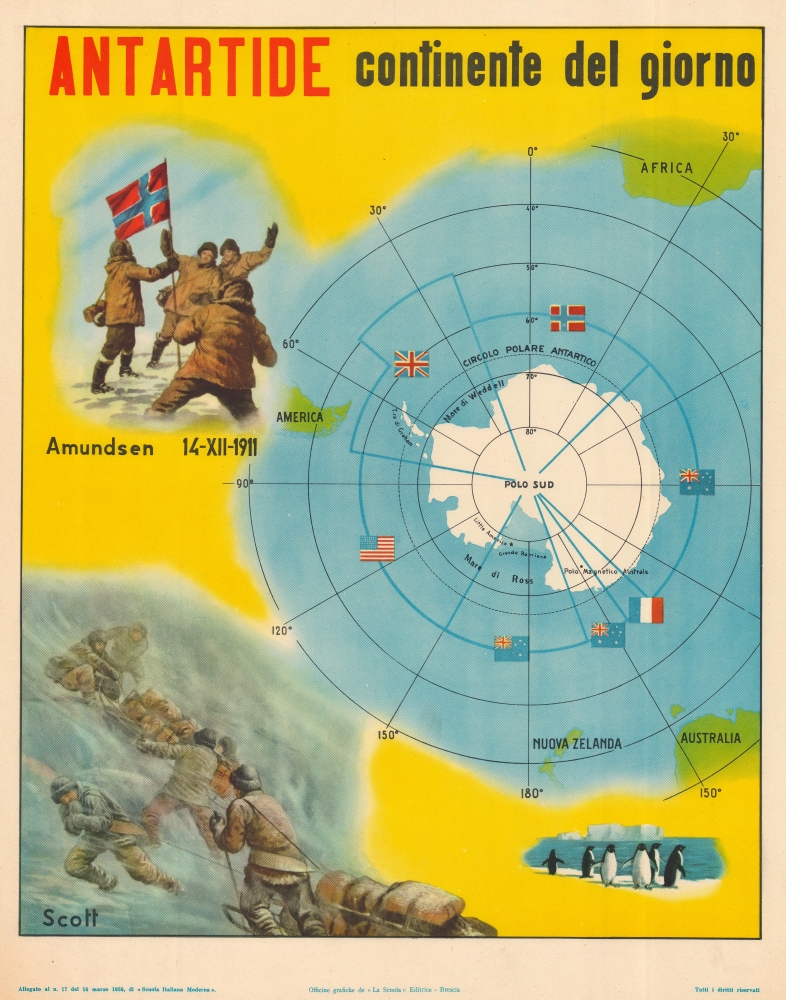This item has been sold, but you can get on the Waitlist to be notified if another example becomes available.
1956 Editrice La Scuola Map of Antarctica with Amundsen and Scott Vignettes
Antartide-editricelascuola-1956
Title
1956 (dated) 20.75 x 16 in (52.705 x 40.64 cm)
Description
The Map
A map of Antarctica occupies most of the sheet. Both the South Pole and Magnetic South Pole are marked, along with the Ross and Weddell Seas and the Great Barrier, today known as the Ross Ice Shelf. The only other marked location is 'Little America,' a series of Antarctic bases operated by Americans sporadically from 1929 through 1956, all within 30 miles of one another. The first was established in 1929 by Richard Byrd during his First Antarctic Expedition, and the last was set up as part of Operation Deep Freeze. The flags of six nations (Australia, France, Great Britain, Norway, New Zealand, and the United States) appear around Antarctica and reference territorial claims (the U.S. has never claimed territory in Antarctica). In 1958, the United States hosted negotiations that resulted in the Antarctic Treaty (Antarctic Treaty System), which went into effect on June 23, 1961. Twelve countries originally signed the treaty, and as of 2024, there are 56 parties.The Vignettes - Antarctic Exploration
Three vignettes adorn three of the corners. The smallest, in the lower right, features a waddle of Adélie penguins. The other two vignettes illustrate the Antarctic expeditions of Norwegian explorer Roald Amundsen and British explorer Robert Falcon Scott, respectively. Both expeditions reached Antarctica in 1911 in a race to the South Pole. The top vignette imagines the Amundsen expedition's celebration upon reaching the South Pole on December 14, 1911, and features them raising the Norwegian flag. Amundsen and his men returned to their base camp and then to Norway. The lower expedition illustrates Scott's expedition fighting an Antarctic storm while pulling heavy sleds. Scott and his party arrived at the Pole a month after Amundsen and could clearly see the Norwegian flag from a distance. Scott and the rest of his group perished during the return journey.The Race to the South Pole
History remembers the 'Race to the South Pole' between Amundsen and Scott as just that, a race. However, it was not intended as such. Amundsen had been organizing an Arctic expedition since 1908, but in 1909, after Cook and Peary both reached the North Pole, Amundsen decided to change course. He had wanted to be the first to the North Pole and had told his supporters as such. He believed that considering Cook and Peary's accomplishments, there was less prestige surrounding a North Pole expedition. Thus, Amundsen changed his mind about attempting to reach the North Pole and decided to go for the South Pole, which had not yet been reached.Scott had been organizing an Antarctic expedition since 1909 and even sent equipment to Amundsen so that they could take comparable readings at opposite poles. Scott left Cardiff on June 15, 1910, and did not reach Antarctica until November. He established a base at Cape Evans where they waited out the Antarctic winter and prepared for their attempt at the pole.
Amundsen left Norway in August 1910, with everyone still believing they were heading north. Amundson had elected not to tell his crew before leaving and only told them after they left their last port of call, Madeira. Amundsen's expedition arrived in Antarctica in January 1911 and established a basecamp 60 miles closer to the South Pole than Scott. They also wintered in there and prepared for their attempt.
Amundsen and four others set out for the Pole on October 19, 1911. Scott and his team waited another few weeks, departing on November 1, 1911. Amundsen's expedition experienced little hardship and arrived at the South Pole on December 14, 1911, winning the 'race.' Scott's team reached the South Pole a month later, on January 17, 1912, and immediately found the tent Amundsen's group had left, complete with a Norwegian flag. Amundsen and his men returned to their base camp triumphant and went on to a successful speaking tour. Scott and his team, by contrast, all perished during the return trek.
Publication History and Census
This map was created by an unknown artist in the Officine Grafiche de 'La Scuola' in Brescia, Italy, and published by Editrice La Scuola in 1956 in 'Scuola Italiana Moderna.' There are two editions, this being the 2nd, but there are no substantive differences. We note cataloged examples at the David Rumsey Map Collection and the Newberry Library. This map appears on the market occasionally.Cartographer
Editrice La Scuola (1904 - present) is an Italian publishing house based in Brescia, Italy that focuses on education and related topics. Founded by a group of lawyers, intellectuals, and political figures, it was initially intended to allow for the continued publication of Scuola Italiana Moderna, a magazine aimed at primary school students founded by Giuseppe Tovini in 1893. The publishing house historically had a close relationship with the Università Cattolica del Sacro Cuore and helped to found a branch campus of the university in Brescia. In recent decades, it has also collaborated closely with the (secular) Università degli Studi di Brescia. It continues to publish periodicals intended for schoolchildren, as well as those on related topics such as pedagogy. More by this mapmaker...

